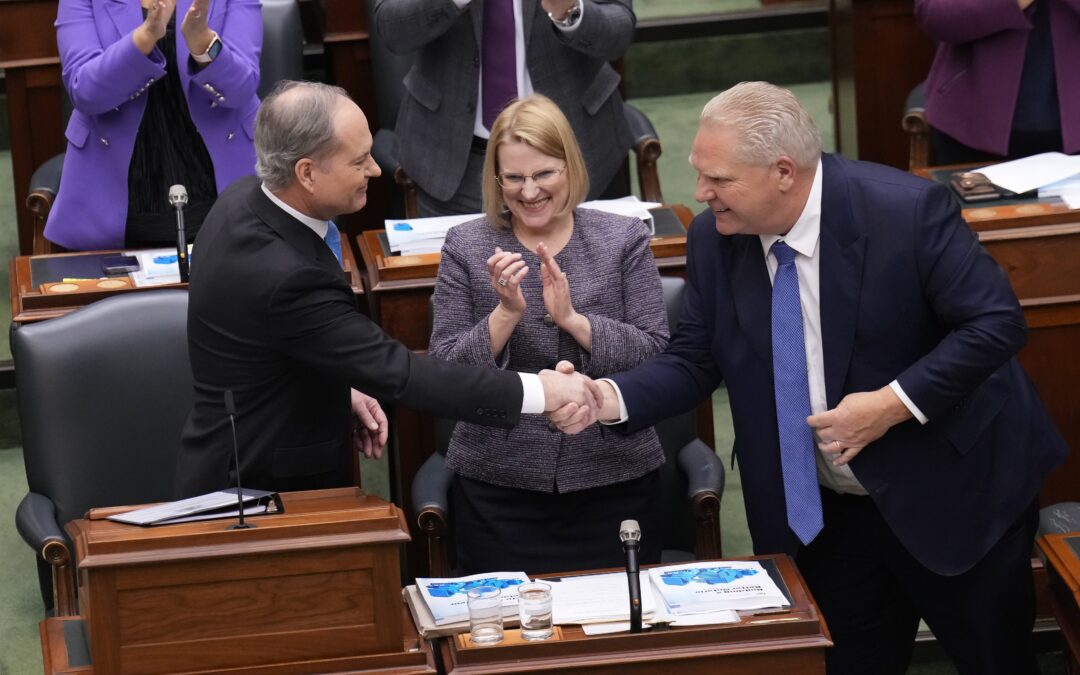Top Line
- Large shift in deficit numbers, climbing to $9.8 billion in the coming fiscal year and pushing a projected balanced budget off to 2026-27.
- No new provincial taxes.
- Projected GDP growth of just 0.3% next year, a particularly anemic rate of growth considering population growth.
- No new costs imposed for businesses or municipalities.
- Major investments in housing and “housing supportive” infrastructure.
- Making auto insurance accident benefit coverage mandatory while making other benefits optional.
Fiscal Highlights
- Total Revenue: $204.3 billion (2023-24)
- Notably, revenue in 2018 was $153 billion, showing that the Ford government has enjoyed strong revenue growth over its term in office, though in this fiscal year and the next, this revenue growth is slowing, which is causing a delay in balancing the budget.
- Total Expenditure: $207.3 billion (2023-24)
- Deficit: $3.0 billion (2023-24) but climbing to $9.8 billion in fiscal year 2024-25.
- Debt Numbers: $439 billion Net Debt ($27,405 per capita), higher than anticipated borrowing at $41.8 billion. Net debt to GDP trending in right direction going from 39.3% in 2018 to 38% in 2023-24 along with the interest amount paid on debt (as a percent of revenue), which has gone from 8.1% in 2018 to 6.3% in 2023-24.
- Employment Numbers: 183,200 net new jobs added last year, last 3 years is highest on record. Unemployment at 6.7% for 2024, expected to decrease to 6.2% by 2027.
- 2.6% inflation this year before moving to 2% next year, though this reflects a slowing economy with real GDP growth coming in at only 0.3% in 2024-25.
- Housing starts projection: 87,900 (well below what is needed to meet the 1.5 million new homes in 10 years target).
- What’s changed: In November’s Fall Economic Statement, the government predicted a $5.3 billion deficit in 2024-25 and balancing the budget in fiscal 2025-26. The fiscal picture has since worsened with a $9.8 billion predicted for 2024–25 and $4.6 billion predicted in 2025–26 before finally returning to the black with a small surplus of $0.5 billion in 2026–27.
Ontario’s Official Budget documents can be found here: 2024 Ontario Budget | Building a Better Ontario
Context
Ontario Finance Minister, Peter Bethlenfalvy has tabled his fourth Ontario Budget. In Bethlenfalvy, Premier Ford has found his steady hand-on-the-till that most government’s look for to demonstrate long-term economic stability to investors and financial markets.
His prudent management style has been put to the test in dealing with the consequences of Bill 124 which virtually froze public sector wages for many years, but was recently reversed by the courts, forcing billions in back-pay and new public-sector contracts to be negotiated. The Finance Minister has been preparing for the court’s decision like a squirrel prepares for a harsh winter. As a result, any chilling effect on Ontario’s finances will be much less than it otherwise could have been, as most of the impact of the court decision has already been factored and paid for.
In sum, today’s Budget was relatively modest in terms of substantial new funding commitments – though the Minister took the opportunity to highlight many old promises, especially the politically popular ones! There were a number of highlights to both base funding increases and new program spending that reflect several core, politically-important areas of focus that are closely-aligned with the government’s priorities: health care service delivery, infrastructure and housing.
Several of these budget announcements were leaked or pre-announced in the past few days, so today’s speech was anti-climactic to some. In fact, the signature item of this year’s budget was announced last Thursday at a muddy construction site in Richmond Hill. At that event, a $1.8 billion investment in municipal “housing enabling” infrastructure was announced. This funding is meant to enable and accelerate new housing in more communities – a top priority for a government oft criticized for not getting enough housing built.
Other pre-announced measures included an extension to the gas tax cut through December 2024; a new medical school in Vaughan aimed at tackling family doctor shortages; greater optionality for drivers purchasing auto insurance; and a new name for Ontario’s Infrastructure Bank.
Today’s budget also comes as the government continues to try and move on politically from a challenging 2023 and set an early tone for what the next two years leading into the next provincial election will look like.
Since the government set expectations high with a 2022 re-election campaign promise to “Get it Done,” especially on building new infrastructure, they will need to have results people can see when asking for votes again in 2026. By the time the next election comes around, they will want to say they kept their promises, they “got it done”, and ideally, be in a position to cut the ribbon on the new infrastructure built by the Ford government.
A Growing Deficit
The global economic conditions ultimately shape Ontario’s fiscal story. While inflation levels have finally seemed to come back to earth, the Bank of Canada has so far kept interest rates steady, a cause of much frustration to Premier Ford who has called on the Bank to ease off the pressure and give people a break.
For the fiscal year 2023-24 which ends in a few days, the forecast had been for a modest deficit of $1.3 billion, which has now turned into $3 billion.
Eighteen months ago, the 2024-25 forecast was projected to be a small surplus of $200 million, which has now transformed into a projected $9.6 billion deficit. This enormous swing of nearly $10 billion is largely driven by slowing growth in tax revenues, which itself is reflective of a slowing economy caused by higher interest rates.
Things will not look a lot better for 2025-26 according to the Budget, with a forecast deficit of $4.6 billion compared to the prior estimate of a $4.4 billion surplus.
Yet while the deficit numbers are dramatic – and particularly problematic for a conservative government that aims for balanced budgets – perhaps the most important trend not highlighted in the Budget papers is that with economic growth remaining below inflation and population climbing every year, Ontario is on a downward curve in real GDP growth per capita.
This slower growth is particularly troublesome considering Ontario’s largest trading partner – the United States – has been enjoying strong growth numbers, lower unemployment numbers and productivity growth, but is now itself facing significant headwinds and slower growth projections, not to mention a volatile political situation. In the face of these challenges, Ontario will be hard-pressed to maintain their revenue growth and path to balanced budgets, unless they make hard choices on expenditures or find other ways to raise revenue in the next two budget cycles.
Of course, Ontario is not alone in dealing with these fiscal, growth, and productivity pressures. Alberta predicted much lower surpluses than expected, Saskatchewan and BC are both expected to run deficits this year. Quebec announced one of the largest deficits in its history at $11 billion with no plan for balance until at least 2029-30 and we can expect the Federal finance Minister to deliver similar challenging numbers when she stands in the House of Commons in a few weeks to deliver the federal budget.
Budget Highlights
Budget 2024, titled Building A Better Ontario, is broken into two main themes: “Building Ontario” and “Working for You”:
Building Ontario
- Invest Ontario Fund: $100 million to continue attracting major investments to Ontario.
- Housing Programs: $1 billion for the new Municipal Housing Infrastructure Program Quadrupling the Housing-Enabling Water Systems Fund to total $825 million.
- New Infrastructure Bank Name: Ontario’s Infrastructure Bank is now called the Building Ontario Fund, though no other new details were provided.
- New Community Sport and Recreation Infrastructure Fund: $200 million over three years in a new application-based funding program for sport and recreational facilities.
- A New Medical School: Investing in a new medical school at York University, this is planned to be the first medical school in Canada primarily focused on training family doctors and will be located in Vaughan.
- Critical Repairs for Public Infrastructure: $250 million over three years in critical repairs for key public infrastructure across the province such as courts, detention centres, laboratories and offices.
- Promised supports for shortline rail: Budget 2024 commits the government to exploring ways to support shortline rail.
- Ontario Transit Investment Fund: Annual funding of $5 million to deliver local and intercommunity transportation projects in unserved and underserved areas in Ontario, particularly in rural areas.
- “Digital Twins” Infrastructure Modeling: $5 million to explore the use of digital twins to deliver its public infrastructure projects. Digital twins are virtual models which are continuously updated with data to reflect the most current physical state of the asset more accurately.
- Critical Minerals: $15 million over 3 years to enhance the Critical Minerals Innovation Fund to further support critical minerals development in the province and the creation of Ontario-made intellectual property.
Working for You
- Skills Development Funding: $224 million to expand access to training centres through the Skills Development Fund Capital Stream. $100 million in 2024–25 for the Skills Development Fund Training Stream to help workers and job seekers, including apprentices, get the skills they need to advance in their careers.
- Extending the Gas Tax Cut: The government is proposing to extend these rate cuts so that the rate of tax on gasoline and fuel (diesel) would remain at nine cents per litre until December 31, 2024.
- Auto Insurance Reforms: The government will be proposing to make auto insurance the primary payer for medical and rehabilitation benefits following an auto accident (as opposed to the current model of requiring extended/employed health care plans be primary payer).
- Auto Accident Benefits: Mandatory auto insurance accident benefit coverage will continue to apply to medical, rehabilitation, and attendant care benefits, while all other benefits would become optional.
- Reviewing Benefits Coverage: The government is requesting that the Financial Services Regulatory Authority of Ontario (FSRA) conduct a review of Guidelines that set the Services and Hourly Rates of health care providers working in the accident benefits space. The government is asking FSRA to find administrative and cost efficiencies, which will – they hope – be reflected in lower auto-insurance premiums.
- Affordable & Supportive Housing: $152 million over the next three years to support individuals facing unstable housing conditions and dealing with mental health and addictions challenges.
- Primary Health Care: An additional $546 million over three years to fund primary care for 600,000 people through new and expanded interprofessional care teams.
- Auto Theft and Community Safety: $46 million over three years to support increased patrols and faster response times to major incidents and serious crimes. This is in addition to previously announced $49 million over three years for the Ontario Provincial Police’s Organized Crime Towing and Auto Theft Team and Ontario’s Major Auto Theft Prosecution Response Team.
Opposition Reaction
- NDP: “If you’re looking for change, Ford’s budget is not for you … People are looking for better health care and homes they can afford. Instead, they got an uninspired statement from a government that is out of touch and out of ideas.” Marit Stiles, Leader of the Ontario NDP.
- Ontario Liberal Party: “This is a do-nothing budget. It’s not worth the paper it’s printed on. The Minister concedes economic growth is down and the debt and deficit are up, but he does nothing to help families and local businesses who are struggling. The sad reality is Doug Ford has no intention of making life better for Ontario families and businesses. He is deliberately refusing to fund healthcare, education and the public services we all rely upon. He is choosing to undercut our public institutions so he can further his privatization agenda and help his rich insider friends make more money.” – Bonnie Crombie, Leader of the Ontario Liberal Party
- Green Party: “Presented with the opportunity to deliver real relief to the millions of Ontarians facing a cost of living crisis, the Ford government has responded with a resounding no.” – Mike Schreiner, MPP and Green Party Leader.
What it Means for You
The Budget was, in some ways, typical for a budget delivered midway in a government’s mandate. It was a budget speech full of repeat announcements and examples of projects that are in mid-stream of development. This is particularly true of many signature items of the government’s agenda, like infrastructure, where the planning phases of major new infrastructure projects can be many years, with many more years of construction to follow. It’s hard to point to accomplishments when the highways, subways, hospitals, and schools are still under construction.
With the high cost of the government’s labour obligations after the court finding against Bill 124, combined with uncertainty on the economic front, there just wasn’t much wiggle room for many new announcements. As such, many important stakeholders and economic sectors may walk away from reading this budget disappointed.
That said, the government showed they have their eyes and political interests set squarely on their core constituents: “The little guy”. The budget speech leaned heavily into identifying ways – large and small – that it can make life a little bit more affordable for the average taxpayer. Short of offering major tax cuts, they are left with smaller measures such as freezing tuition, extending gas tax cuts and cutting transit fares. These are meaningful, but ultimately, niche cuts to household expenditures.
What’s Next
The Ontario Legislature is on break next week, which gives time for government MPPs to fan out across Ontario to deliver echo announcements in their communities about the Budget and to highlight many of the “good news” announcements.
In the meantime, your team at Counsel will be diving deeper into the back pages and appendices of the budget, looking for nuggets of gold and details of interest to our various clients.
If you have questions about what this budget means for your sector, business, or association specifically, please reach out to your Ontario Counsel Public Affairs team:
Caroline Pinto, Partner and Co-Founder
cpinto@counselpa.com
416.930.1834
Michael Ras, Senior Vice President, Ontario
mras@counselpa.com
647.228.2339
Devan Sommerville, Vice President, Ontario
dsommerville@counselpa.com
416.920.0716 x 217
Johanna Chevalier, Associate Vice President
jchevalier@counselpa.com
416.434.4102
Rob Elliott, Associate Vice President, Ontario
relliott@counselpa.com
613.371.7210
Felix Burns, Account Director, Ontario
fburns@counselpa.com
905.926.6012
Shawn Cruz, Senior Consultant
scruz@counselpa.com
647.828.3719









